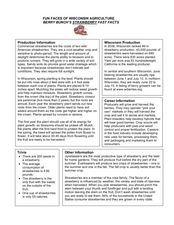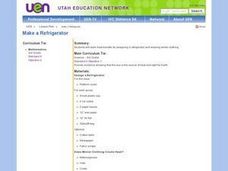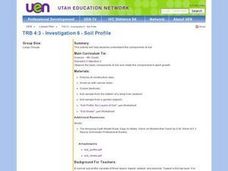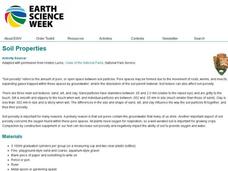Curated OER
Monarch Migration
Third graders investigate the life cycle of the Monarch butterfly. They experiment with various tools to simulate the mouth parts of insects, conduct research, record their observations of butterflies hatching, write a play, complete...
Curated OER
Case of the Missing Pumpkin
Students explore the process of decomposition. In this science lesson, students carve a pumpkin and observe as it decomposes. Students compare the changes to an uncarved pumpkin. Students write about the disappearing pumpkin.
Curated OER
Where Does Food Come From?
Students recognize that food we eat comes from farms. In this where does food come from lesson, students discuss planting crops and how they grow. Students plant seeds for edible crops and eat them when are ripe. Students...
Curated OER
Rain Forest Research
Second graders explore the Rain Forest. In this research lesson, 2nd graders go online to gather information about Rain Forest animals. Students print and use the information to write about the many parts of the Rain Forest. Students are...
Curated OER
Photosynthesis Cookies
Students identify photosynthesis as a process through which organisms make their own food. They practice the process for writing the formula for the photosynthesis equation.
Students describe how the processes of photosynthesis and...
Curated OER
Fun Faces of Wisconsin Agriculture: Berry Bunch's Strawberry Fast Facts
Students use facts about strawberry production in Wisconsin to complete math and art activities. In this strawberry production instructional activity, students read about strawberry production in the state of Wisconsin. They answer math...
Curated OER
Profit From Pumpkins
Third graders cut open a pumpkin. In this math activity, 3rd graders complete the worksheet "From Seed to Pumpkin" and then clean out their pumpkins to see how many seeds are in it.
Curated OER
Make a Refrigerator
Third graders explore the concept of heat transfer as experienced in wearing winter clothing and analyzing the refrigerator.
Curated OER
Investigation 6 - Soil Profile
Fourth graders study the components of soil. They observe the basic components of soil and relate the components to plant growth. They record color, texture, and kinds of materials on their profile log (light color, denser, grittier -...
Curated OER
A Day on the Farm
First graders, with a collection of various art supplies, plant a seed to observe it growing and record specific data on a data record sheet. They create a collage from various magazines of ten different foods farm animals eat and make a...
Curated OER
Breaking News English: Waterproof Genetically-Modified Rice
In this waterproof genetically modified rice worksheet, students read the article, answer true and false questions, complete synonym matching, complete phrase matching, complete a gap fill, answer short answer questions, answer...
Curated OER
Tank Trials - Measuring Germination
Students observe and measure seed germination. In this life science lesson, students use 'tanks' to observe a set of seeds as they germinate and begin growing, make predictions, and record their data. Lesson includes background teacher...
Curated OER
How Groundhog's Garden Grew
Students answer questions based on Bloom's Taxonomy after reading the book, How Groundhog's Garden Grew, by Lynne Cherry. In this reading comprehension lesson, students respond to 6 questions, one per taxonomy level, to...
Curated OER
How Should Our Gardens Grow?
Students examine different types of land use by humans and evaluate the ways land is used in their local community. They also consider the environmental effects of the different types of land use. Students assume the role of community...
Curated OER
Soil Properties
Students explore the porosity of soil. In this soil lesson, students conduct an experiment which shows the porosity of different types of soil. They use sand, silt, and clay to see how soil particles are more or less aerated and thus...
Curated OER
Sustainable Livestock
Young scholars investigate healthy eating habits by researching livestock. In this food sustainability lesson, students research the negative impact factory farming has on our environment due to pollution. Young scholars define...
Forest Foundation
Forest Health
Young foresters examine the strategies, like prescribed burns and thinning, that are employed to ensure healthy forests.
Forest Foundation
The Sustainable Forest
As part of their examination of forest ecosystems, class members examine how foresters, biologists, botanists, geologists, and hydrologists work to together to develop a management plan for sustainable forests.
Curated OER
Ecosystems and Remote Sensing
Young scholars obtain remote sensing data to compare and contrast global biomass data with global temperature data.
Curated OER
The Four Groups of Biologically Important Compounds
This is not they typical set of teacher instructions. It is an organized chart of the important organic compounds. For each, the involved elements, the name of the building block monomers, the names of polymers, extra information, and a...
Curated OER
Nurturing Green Thumbs at School
Incorporating a school garden into the curriculum cultivates many benefits.
American Museum of Natural History
Bio-Benefits
Kick-start a discussion of the importance of biodiversity with a colorful resource that touts the benefits of maintaining healthy ecosystems. The images stress the interdependence of all the elements of an ecosystem.
Curated OER
Speedy Succession
Fifth graders identify how a pond can change into a grassland. An ecosystems lesson where learners identify pioneer and climax species, and recognize that ecological succession can take up to 100 years or more. Some excellent activities...
K12 Reader
What’s Eating You?
Introduce your class to producers, consumers, and pollinators with a reading passage. Class members read the text and respond to five related questions.























